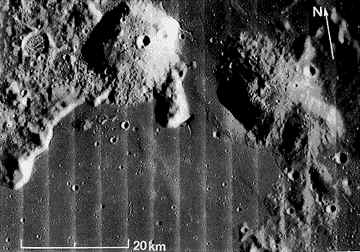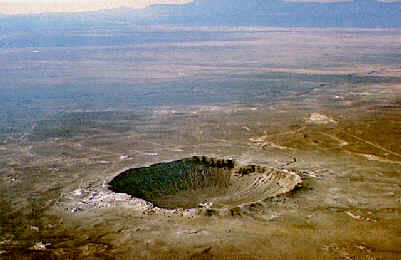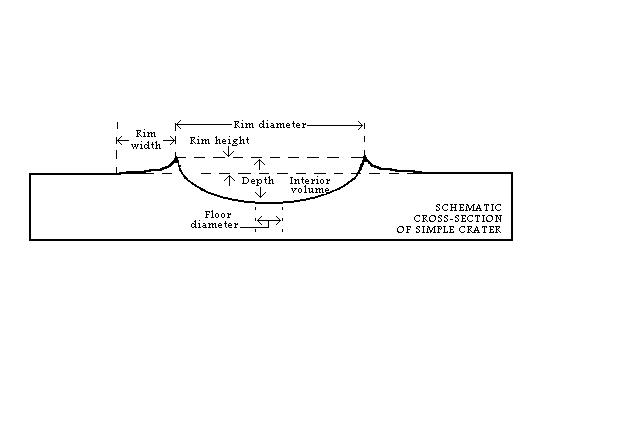

The above pictures show two different types of vehicles used
to gather information upon the lunar surface.Top: Lunokhod 1; robotic roving vehicle, used in 1970 to explore Mare Imbrium.
Bottom: Modularied Equipment Transporter (MET); hand-drawn carrier for tools and lunar samles, used in 1971.
Source: The Lunar Sourcebook, p. 523History of Lunar Exploration Apollo missions: United States
Mission Launch Date Accomplishment Luna 1 01/02/59 first lunar flyby Luna 2 09/12/59 first lunar impact Luna 3 10/04/59 first photos of farside Ranger 3 01/26/62 missed moon by 36,793 km Ranger 4 04/23/62 crashed on farside Ranger 7 07/28/64 impact lander Luna 5 05/09/65 crashed on moon Luna 8 12/03/65 crashed on moon Luna 9 01/31/66 first lunar soft landing Luna 10 03/31/66 first lunar satellite Surveyor 1 05/30/66 first soft-landed robot laboratory Explorer 35 07/19/67 lunar satelitte Surveyor 7 01/07/68 soft-landed robot laboratory Zond 5 09/14/68 first flyby and return Apollo 8 12/21/68 first humans orbit moon Luna 15 07/13/69 crashed on moon Apollo 11 07/16/69 first humans on moon (07/20/69) Luna 16 09/12/70 first robot sample return Luna 17 11/10/70 first robot rover Apollo 12 11/14/69 second human landing Apollo 13 04/11/70 aborted human landing Apollo 14 01/31/71 third human landing Apollo 15 07/26/71 fourth human landing Luna 19 09/28/71 lunar satellite Apollo 16 04/16/72 fifth human landing Apollo 17 12/07/72 sixth human landing Luna 21 01/08/73 robot lunar rover Luna 24 08/09/76 third robot sample return
Luna missions: the former Soviet Union
Source: The Lunar Sourcebook, p.7
Moon's Orbital Path
When the dark hemisphere of the moon is facing the earth and the moon is mot visible, this phase is new moon. As the moon continues in its orbit, we see the moon as a slim crescent, called waxing crescent moon. The next phase reached is first quarter moon, when half of the moon is illuminated. The moon continues along its orbit passing through the next phase called waxing gibbous moon. Soon after, the moon is fully illuminated at full moon. After the full moon, the moon begins waning, or decreasing illumination while orbiting to the next new moon. The first phase reached after a full moon is waning gibbous moon. Next comes last quarter, when the left half of the moon is illuminated. A few days after, we see the moon again as a slim crescent, in waning crescent moon. The moon continues in its orbit again to reach new moon. The orbital period of the moon takes 27.3 days.
Source: Universe; fifth edition, pp. 51-53
Lunar Rocks
Terrae
- Original mantle
- Light in color
- Composed of light elements (Silicon, Calcium, and Aluminum)
- 85% of lunar surface
- Accounts for little of moon's actual mass
- Extends 1000km below surface
Image taken in Hawaii of different aged magma flows. The darker the flow the more recent. The is comparable to the terrae and mare of the moon.
Maria ("MAR-ee-uh")
Translation of Latin is Sea Formed when crust weakened from planetesmal collision allowing magma to reach surface Cooled on top of older crust tera Dark in coloring Composed of heavey elements (Iron, Manganese, and Titanium) 15% of lunar surface This is an image of the impact basin Mare Moscoviense on the lunar farside. You can see clearly the distinction between the mare and the terrea.
Domes
Remnants of magma vents Size ranges from less than a mile to more than 22 miles Generally found in clusters Have a slight slope

Craters

http://cass.jsc.nasa.gov/images/simp/simp_S06.gif
This is an example of an impact crater on Earth in the Arizona desert.
- Caused by impacts of planetary objects
- Shock waves always produce circulaar craters
- Two types (Complex or Simple Craters)
- Size ranges from 100km across to a couple cm across
- Depth ranges from several hundred of feet to a couple cm
This is an image of an impact crater on the near side of the moon.

 Source:
The Lunar Sourcebook, p. 64
Source:
The Lunar Sourcebook, p. 64
Simple craters are mostly small, rounded craters, though some have a flat bottom. As the diameter of craters increases, they tend to become more shallow, and the walls and floors of the crater are ridged.
Source: The Lunar Sourcebook, p. 62
Culture
Influences on Native American Life
In the ancient culture of Native Americans, the moon served as a timekeeper and calendar, a schedule to plant and harvest crops by, an indicator for prime hunting times, and served as a mythological icon for folklore and ritual.Detailed accounts of births, deaths, eclipses, comets, and other events recorded by ancient people are accurate with their counting by the moon.
Native Americans knew that certain crops, either above ground crops or root crops, could be planted during certain phases of the moon for optimal produce .
Hunting parties set out in search of meat during full moons, when there would be the maximum amount of light overhead, and animals such as deer were very active, and therefore easier to locate.
Coastal tribes used the moon to capture as much fish as possible, knowing that sea life reproducing in synch with full moons were vulnerable, and often out of water and easily collected.It is commonly known among Native American cultures that tribal women share a special bond with the moon. A typical Native American myth assigns the moon as a female entity, and many refer to the moon as Grandmother Moon.
The connection between the moon and women in Native American culture is strong, and is an important part of the identity of contemporary Native women.
The Native Americans of today continue to honor the moon as a celestial spirit, and value the moon as a reminder of a civilization lost.
| Home | Interim Report | Final Repot | Presentation | Bibliography and links of interest |
| Observations | Astronomy & Cosmology Program | The Evergreen State College | Jennifer Nicholson | Roxanne Murray |